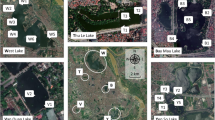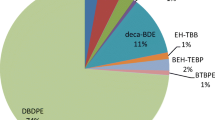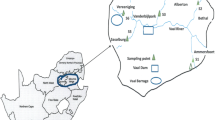Abstract
The reduction in the use of polybrominated diphenyl ethers (PBDEs) and hexabromocyclododecane (HBCD) has opened the way for the introduction of novel brominated flame retardants (NBFRs) in place of the banned formulations. Important representatives of this group are decabromodiphenyl ethane (DBDPE), 1,2-bis(2,4,6-tribromophenoxy) ethane (BTBPE), hexabromobenzene (HBB), and pentabromoethylbenzene (PBEB). In this study, the contamination due to NBRFs was investigated for the first time in Italy in the sediments of Lake Maggiore. The aim of the research was to characterize in detail the possible presence of temporal trends and/or to identify potential sources of contamination. The study also considered the PBDE and HBCD lake sediment’s current contamination. The analytical results showed that sediments in Lake Maggiore and its tributary rivers had weak concentrations of PBEB, HBB, and BTBPE, but they did not have a negligible/insignificant contamination of HBCD (up to 23.7 ng/g dry weight (d.w.)). The determination of PBDEs in sediments showed that BDE-209 was the predominant congener (up to 217 and 28 ng/g d.w. in river and lake sediments, respectively). DBDPE was detected in the sediments with relevant concentrations (up to 280 ng/g d.w in the River Boesio sediments). The positive correlation of DBDPE with BDE-209 confirmed the wide and important use of this compound in the Lake Maggiore basin and the hypothesis that this compound will soon become one of the most important NBFRs used in Northern Italy. The contamination of Lake Maggiore sediments due to PBDEs, HBCD, and NBFRs were comparable to other worldwide situations.



Similar content being viewed by others
References
Abdallah, M. A.-E., & Harrad, S. (2011). Tetrabromobisphenol-A, hexabromocyclododecane and its degradation products in UK human milk: relationship to external exposure. Environment International, 37(2), 443–448.
Arias, PA. (2001). Brominated flame retardants—an overview. The Second International Workshop on Brominated Flame Retardants (BFR 2001), May 14–16, Stockholm, 17–19.
Baudo, R., Amantini, L., Bo, F., Cenci, R., Hannaert, P., Lattanzio, A., Marengo, G., & Muntau, H. (1989). Spatial distribution patterns of metals in the surface sediments of Lake Orta (Italy). Science of the Total Environment, 87(88), 117–128.
Betts, K. (2008). New flame retardants detected in indoor and outdoor environments. Environmental Science & Technology, 42(18), 6778.
Cai, M. G., Hong, Q. Q., Wang, Y., Luo, X. J., Chen, S. J., Cai, M. H., Qiu, C. R., Huang, S. Y., & Mai, B. X. (2012). Distribution of polybrominated diphenyl ethers and decabromodiphenylethane in surface sediments from the Bering Sea, Chukchi Sea, and Canada Basin. Deep-Sea Research II, 81(84), 95–101.
CIPAIS, 2012 Indagini su DDT e sostanze pericolosenell’ecosistema del Lago Maggiore. Rapporto annuale 2012; Rapporto finale 2008-2012. In Italian.
Covaci, A., Harrad, S., Abdallah, M. A.-E., Ali, N., Law, R. J., Herzke, D., et al. (2011). Novel brominated flame retardants: a review of their analysis, environmental fate and behaviour. Environment International, 37(2), 532–556.
de Wit, C. A. (2002). An overview of brominated flame retardants in the environment. Chemosphere, 46(5), 583–624.
de Wit, C. A., Herzke, D., & Vorkamp, K. (2010). Brominated flame retardants in the Arctic environment–trends and new candidates. Science of the Total Environment, 408(15), 2885–2918.
Directive 2003/11/EC of the European Parliament and of the Council of 6 February 2003 amending for the 24th time Council Directive 76/769/EEC relating to restrictions on the marketing and use of certain dangerous substances and preparations (pentabromodiphenyl ether and octabromodiphenyl ether). Official Journal of the European Union, L42/45, 15/02/2003.
European Court of Justice. Cases C-14/06 and C-295/06, Judgement of the Court, 1 April 2008, Directive 2002/95/EC and Commission Decision 2005/717/EC. 2008.
Gauthier, L. T., Hebert, C. E., Weseloh, D. V. C., & Letcher, R. J. (2007). Current-use flame retardants in the eggs of herring gulls (Larusar gentatus) from the Laurentian Great Lakes. Environmental Science & Technology, 41(13), 4561–4567.
Gauthier, L. T., Potter, D., Hebert, C. E., & Letcher, R. J. (2009). Temporal trends and spatial distribution of non-polybrominated diphenyl ether flame retardants in the eggs of colonial populations of Great Lakes herring gulls. Environmental Science & Technology, 43(2), 312–317.
Gerecke, A. C., Kohler, M., Zennegg, M., Schmid, P., & Heeb, N. V. (2003). Detection of aisomer dominated HBCD (hexabromocyclododecane) in Swiss fish at levels comparable to PBDEs (polybrominated diphenyl ethers). Organohalogen Compounds, 61, 155–158.
Gouteux, B., Alaee, M., Mabury, S. A., Pacepavicius, G., & Muir, D. C. G. (2008). Polymeric brominated flame retardants: are they a relevant source of emerging brominated aromatic compounds in the environment? Environmental Science & Technology, 42(24), 9039–9044.
Guerra, P., Eljarrat, E., & Barcelò, D. (2010). Analysis and occurrence of emerging brominated flame retardants in the Llobregat River basin. Journal of Hydrology, 383(1–2), 39–43.
Guzzella, L., Roscioli, R., & Binelli, A. (2008). Contamination by polybrominated diphenyl ethers of sediments from the Lake Maggiore Basin (Italy and Switzerland). Chemosphere, 73(10), 1684–1691.
Harrad, S., Abdallah, M. A.-E., Rose, N. L., Turner, S. D., & Davidson, T. A. (2009). Current-use brominated flame retardants in water, sediment, and fish from English lakes. Environmental Science & Technology, 43(24), 9077–9083.
Hoh, E., Zhu, L., & Hites, R. A. (2005). Novel flame retardants, 1, 2-bis(2,4,6-ribromophenoxy)ethane and 2,3,4,5,6-pentabromoethylbenzene, in United States’ environmental samples. Environmental Science & Technology, 39(8), 2472–2477.
Klosterhaus, S. L., Stapleton, H. M., La Guardia, M. J., & Greig, D. J. (2012). Brominated and chlorinated flame retardants in San Francisco Bay sediments and wildlife. Environment International, 47(Oct 2012), 56–65.
La Guardia, M. J., Hale, R. C., & Harvey, E. (2006). Detailed polybrominated diphenyl ether (PBDE) congener composition of the widely used penta-, octa-, and deca-PBDE technical flame-retardant mixtures. Environmental Science & Technology, 40, 6247–6254.
Marchetto, A., Lami, A., Musazzi, S., Massaferro, J., Langone, L., & Guilizzoni, P. (2004). Lake Maggiore (N. Italy) trophic history: fossil diatom, plant pigments, and chironomids and comparison with long-term limnological data. Quaternary International, 113(1), 97–110.
OSPAR Commission. OSPAR List of Chemicals for Priority Action. Update 2007. http://www.ospar.org/content/content.asp?menu=00120000000074_000000_0000002001.
Renner, R. (2004). In US, flame retardants will be voluntarily phased out. Environmental Science & Technology, 38(1), 14A.
Sawal, G., Stachel, B., Lepom, P. (2004). Polybrominated diphenyl ethers in sediments from the river Elbe, Germany. Proceedings of the Third International Workshop on Brominated Flame Retardants BFR2004. Toronto, Canada, June 6–9, 2004, 151–154.
Sjödin, A., Jakobsson, E., Kierkegaard, A., Marsh, G., & Sellström, U. (1998). Gas chromatographic identification and quantification of polybrominated diphenyl ethers in a commercial product Bromkal70-5DE. Journal of Chromatography A, 822, 83–89.
Söderström, G., Sellström, U., de Wit, C. A., & Tysklind, M. (2004). Photolytic debromination of decabromodiphenyl ether (BDE 209). Environmental Science & Technology, 38, 127–132.
Verreault, J., Gebbink, W., Gauthier, L. T., Gabrielsen, G. W., & Letcher, R. J. (2007). Brominated flame retardants in Glaucous Gulls from the Norwegian arctic: more than just an issue of polybrominated diphenyl ethers. Environmental Science & Technology, 41(14), 4925–4931.
Voorspoels, S., Covaci, A., & Schepens, P. (2003). Polybrominated diphenyl ethers in marine speciesfrom the Belgian North Sea and the Western Scheldt estuary: levels, profiles and distribution. Environmental Science & Technology, 37, 4348–4357.
Walkley, A., & Black, I. A. (1934). An examination of the Degtjareff method for determining soil organic matter and a proposed modification of the chromic acid titration method. Soil Science, 37(1), 29–38.
Watanabe, I., & Sakai, S. (2003). Environmental release and behavior of brominated flame retardants. Environment International, 29(6), 665–682.
Wei, H., Aziz-Schwanbeck, A. C., Zou, Y., Corcoran, M. B., Poghosyan, A., Li, A., Rockne, K. J., Christensen, E. R., & Sturchio, N. C. (2012). Polybromodiphenyl ethers and decabromodiphenyl ethane in aquatic sediments from Southern and Eastern Arkansas, United States. Environmental Science & Technology, 46(15), 8017–8024.
Wu, J.P., Guan, Y.T., Zhang, Y., Luo, X.J., Zhi, H., Chen, S.J., Mai, B.X., 2010. Trophodynamics of hexabromocyclododecanes and several other non-PBDE brominated flame retardants in a freshwater food web. Environmental Science & Technology, 44(14), 5490-5495.
WHO World Health Organization, Geneva. (1997). Flame retardants: a general introduction, 192. Environmental Health Criteria.
Zhu, L., Ma, B., & Hites, R. A. (2009). Brominated flame retardants in serum from the general population in Northern China. Environmental Science & Technology, 43(18), 6963–6968.
Acknowledgments
The authors thank P. Guilizzoni and A. Lami of ISE-CNR (Pallanza), for sampling and dating lake sediments, and Commissione Internazionale per la Protezionedelle AcqueItalo-Svizzere (CIPAIS), for partially supporting this study economically.
Author information
Authors and Affiliations
Corresponding author
Electronic supplementary material
Below is the link to the electronic supplementary material.
ESM 1
(PDF 280 kb)
Rights and permissions
About this article
Cite this article
Poma, G., Roscioli, C. & Guzzella, L. PBDE, HBCD, and novel brominated flame retardant contamination in sediments from Lake Maggiore (Northern Italy). Environ Monit Assess 186, 7683–7692 (2014). https://doi.org/10.1007/s10661-014-3959-3
Received:
Accepted:
Published:
Issue Date:
DOI: https://doi.org/10.1007/s10661-014-3959-3




